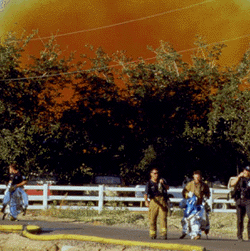 The orange cloud in this scene is a release of Nitric Acid in progress. It
came from tanks at an "agricultural" operation that did not understand it
had to report the Nitric Acid under EPCRA Section 302, and the "release"
under EPCRA Section 304 and CERCLA Section 103. The firefighters did not
know what this colored plume was because of the failure to report.
FORTUNATELY, the cloud was colored and visible. Not all spills are colored.
Not all spills are during daylight hours either. The neighbors called the
fire department, not the facility.
The orange cloud in this scene is a release of Nitric Acid in progress. It
came from tanks at an "agricultural" operation that did not understand it
had to report the Nitric Acid under EPCRA Section 302, and the "release"
under EPCRA Section 304 and CERCLA Section 103. The firefighters did not
know what this colored plume was because of the failure to report.
FORTUNATELY, the cloud was colored and visible. Not all spills are colored.
Not all spills are during daylight hours either. The neighbors called the
fire department, not the facility.
Note the firefighters suiting up in protective gear. Other hazardous chemicals were stored at this facility, and the Nitric Acid ate into the other tanks. This was something the facility owner/operator never considered could happen. Over 200 people reported adverse health effects from exposure to the Nitric Acid fumes in a follow-up health survey.
 No one could tell just by looking at these containers what chemicals are in
them because they are not labled. But some of these containers have strong
acids in them. Putting water on acids can cause an explosion. A well-written
Tier Two Report would be helpful here to a firefighter, but more detailed
information would even be better. The BOLDER Project has the answer to this.
No one could tell just by looking at these containers what chemicals are in
them because they are not labled. But some of these containers have strong
acids in them. Putting water on acids can cause an explosion. A well-written
Tier Two Report would be helpful here to a firefighter, but more detailed
information would even be better. The BOLDER Project has the answer to this.
Photo #2
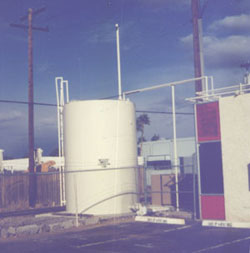 This tank is part of an Anhydrous (waterless) Ammonia refrigeration system.
Until citizens brought suit to make the facility file Tier Two Reports, it
had not complied with EPCRA. The plastic tank was behind the building and
next to railroad tracks. The Anhydrous Ammonia refrigeration system held
over 5,000 pounds of Anhydrous Ammonia, enough to affect people on the
nearby and busy Interstate highway if the system spilled and the winds had
carried the fumes there. What would emergency responders have done if this
happened? They would not have known the source of the Ammonia.
This tank is part of an Anhydrous (waterless) Ammonia refrigeration system.
Until citizens brought suit to make the facility file Tier Two Reports, it
had not complied with EPCRA. The plastic tank was behind the building and
next to railroad tracks. The Anhydrous Ammonia refrigeration system held
over 5,000 pounds of Anhydrous Ammonia, enough to affect people on the
nearby and busy Interstate highway if the system spilled and the winds had
carried the fumes there. What would emergency responders have done if this
happened? They would not have known the source of the Ammonia.
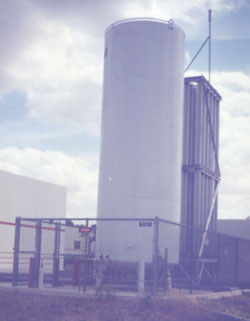 These enormous tanks of Hydrogen and Oxygen were not reported until citizens
brought suit to make the facility file Tier Two Reports and comply with
EPCRA. There had also been problems with these tanks leaking! This potential
bomb was in an industrial park. Imagine the firefighters trying to respond
to such a catastrophe! The names of the chemicals are on the tanks, but not
easy to discern. The facility also had reportable quantities of Hydrofluoric
Acid.
These enormous tanks of Hydrogen and Oxygen were not reported until citizens
brought suit to make the facility file Tier Two Reports and comply with
EPCRA. There had also been problems with these tanks leaking! This potential
bomb was in an industrial park. Imagine the firefighters trying to respond
to such a catastrophe! The names of the chemicals are on the tanks, but not
easy to discern. The facility also had reportable quantities of Hydrofluoric
Acid.
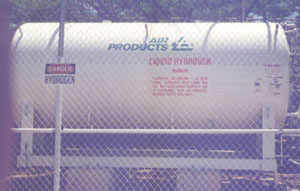 This well-labeled tank of Hydrogen does not have 10,000 pounds of Hydrogen,
so a Tier Two Report is not required if this is all the Hydrogen on-site at
the facility. Of course, it would be a good idea to report it anyway. There
is still enough Hydrogen to cause a problem.
This well-labeled tank of Hydrogen does not have 10,000 pounds of Hydrogen,
so a Tier Two Report is not required if this is all the Hydrogen on-site at
the facility. Of course, it would be a good idea to report it anyway. There
is still enough Hydrogen to cause a problem.
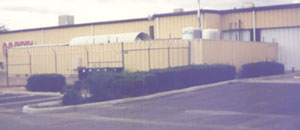 The largest tank has a type of freon in it, enough to be reported on a Tier
Two Report. Imagine a firefighter rolling up on this scene in the middle of
the night while trying to respond to a chemical spill or fire. No labels
visible, view partially obscured. All the firefighters would know is that
there is a large tank of something, and other tanks. Unless the firefighters
had the Tier Two Reports with them, an efficient response would be
difficult. The BOLDER Project helps to solve this problem by putting
real-time site information in the hands of firefighters at the scene,
complete with site-maps, photo attachments, and more.
The largest tank has a type of freon in it, enough to be reported on a Tier
Two Report. Imagine a firefighter rolling up on this scene in the middle of
the night while trying to respond to a chemical spill or fire. No labels
visible, view partially obscured. All the firefighters would know is that
there is a large tank of something, and other tanks. Unless the firefighters
had the Tier Two Reports with them, an efficient response would be
difficult. The BOLDER Project helps to solve this problem by putting
real-time site information in the hands of firefighters at the scene,
complete with site-maps, photo attachments, and more.
Photo #6
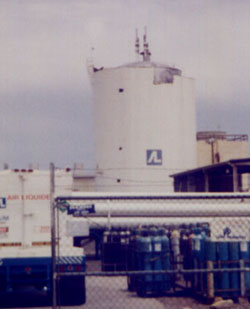 This complex site has a number of different industrial gases. With the Tier
Two information, firefighters would still have a difficult time dealing with
a fire at this facility, which actually had explosions and fires two years
after this photo was taken. The explosions sent debris flying into the air
that damaged neighboring businesses. The heat of the fire destroyed many
automobiles parked nearby. These enormous tanks and smaller ones were not
reported until citizens brought suit to make the facility file Tier Two
Reports and comply with EPCRA. The facility had actually sent in a letter
stating that it did not have enough on-site to require reporting!
Fortunately, alert citizens brought EPCRA citizen suit BEFORE the disaster
occurred, and made emergency and disaster training for the site's employees
part of the settlement. Even with EPCRA compliance, accidents will happen.
The firefighters had access to the facility's Tier Two Reports and site
information, and they knew to NOT pour water on certain chemicals at the
site that form acetylene gas (flammable) when exposed to water.
This complex site has a number of different industrial gases. With the Tier
Two information, firefighters would still have a difficult time dealing with
a fire at this facility, which actually had explosions and fires two years
after this photo was taken. The explosions sent debris flying into the air
that damaged neighboring businesses. The heat of the fire destroyed many
automobiles parked nearby. These enormous tanks and smaller ones were not
reported until citizens brought suit to make the facility file Tier Two
Reports and comply with EPCRA. The facility had actually sent in a letter
stating that it did not have enough on-site to require reporting!
Fortunately, alert citizens brought EPCRA citizen suit BEFORE the disaster
occurred, and made emergency and disaster training for the site's employees
part of the settlement. Even with EPCRA compliance, accidents will happen.
The firefighters had access to the facility's Tier Two Reports and site
information, and they knew to NOT pour water on certain chemicals at the
site that form acetylene gas (flammable) when exposed to water.